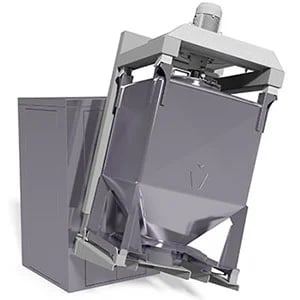Achieving the perfect blend is essential when making a high-quality product for the discerning consumer or to meet regulatory controls. To do that, you need the most suitable equipment for the job: a blender that is ideally suited to your recipes, your production line and your customers' demands. If you've already started the search for an industrial mixer for your premises, you'll have discovered a range of different styles from ribbon blenders and high shear blenders to tumble blenders. In this blog, we explore the world of tumble blending, what it is, how it works and the benefits it can bring to your business…
What is Tumble Blending?
A tumble blender is a rotating mixing machine which comes in a variety of styles, including the IBC (Intermediate Bulk Container) Blender, the V-shaped blender and double-cone configuration. It is widely considered to be a low-impact mechanism for blending.
Regardless of geometry, the tumble blender usually turns at an operating speed of between 5 to 25 rpm, depending on the ingredients to be blended.
How does a Tumble Blender Work?
Tumble blenders encourage product to do just what the name of the blender suggests – tumble. Diffusion is therefore the main mechanism for mixing as particles roll, cascade and fall over each exposed surface as the vessel rotates on a horizontal axis. In a V-shaped blender, the batch is continuously being split and recombined across the two sides of the vessel.
To take advantage of this mixing and flow pattern, raw materials are typically loaded into the vessel in layers rather than side-by-side.
As tumble blending is low shear, it’s especially well-suited to mixing dense powders, fragile solids and abrasive materials such as bakery mixes, cereals and milk powders. It’s also regularly used when blends contain trace components or when using ingredients that are different in size and density.
Tumble blenders deliver highly accurate and repeatable mixing of recipes which therefore suits any applications using regulatory standards.

Why Choose a Tumble Blender?
Tumble blenders are ideal when product mixes require gentle handling. Traditional wisdom stated that if you need to blend sticky powders or tough, lumpy ingredients, a high shear blender would suit your needs better. But some of today’s manufacturers of tumble blenders have added this high shear element in the form of Intensifiers which are fitted to the blender to apply force to the material and break agglomerates. This has expanded the range of tumble blending to accommodate recipes that have a higher fat content – indeed the bakery industry is able to use this technology for single stage mixing.
Tumble blenders are easy to control, some offering variable frequency drives to allow a soft, slow start when they’re fully loaded. The rpm rate can also be adjusted so that the cascading motion of the product can be carefully controlled. You can even programme them to stop automatically after a specific number of revolutions.
There’s Tumble Blending and There’s Matcon Tumble Blending
The greatest success story for tumble blending lies with the IBC blender. It offers full manufacturing flexibility to its customers. Because the IBC itself becomes the blending vessel there is no product contact with the blender so recipe changeovers can be instantaneous. Simply load on the next IBC without worrying about cleaning and cross-contamination. Ingredients can be prepared within the IBC off-line, moved to the industrial mixer and blended in-bin before being transported, within the same IBC, to the packing line. This makes for the leanest and most efficient production process available.
View our short film to see how a Matcon system compares with a traditional fixed-line mixer system. Both are producing the same recipes and batch sizes but the time savings are obvious.
With the Matcon IBC blender we see our customers being able to mix 3-4 batches per hour without any down-time of the mixing process. A dramatic uplift from the 1 batch an hour they were making with their traditional ribbon blender.
The small footprint that the Matcon IBC Blender occupies has an additional benefit of saving building space, which is of particular note if clean rooms need to be created to house the industrial mixer. In addition, a single IBC blender can accommodate the full range of Matcon IBCs so there is no need to purchase additional mixers to match different batch sizes. A saving on both the blender cost and space costs too.
You can fully assess whether tumble blender is right for you by requesting a blending trial from Matcon at one of their testing plants. You can use your own raw ingredients to closely simulate your production process.
We are further enhancing this service by offering the latest in sampling technology using NIR (near infra-red spectroscopy), which identifies the point at which a batch reaches homogeneity. By using NIR we are able to give results in real-time and remove the use of invasive sampling. This data can be used back in your factory to prevent over-mixing and keep blend times to a minimum.
Related reading:
- Flexible Manufacturing with Reduced Industrial Mixer Blending Time
- The Matcon Tumble Blending Approach to the Industrial Mixer
- Benefits of Quick Recipe Changeovers and No Clean Industrial Mixers
- Increasing Flexibility With The Right Industrial Mixer
- Dispelling Industrial Mixer Myths
- 5 Things to Consider When Choosing an Industrial Mixer
To help you make an informed decision, take a look at our 4 step guide to choosing the right blender.
Topics:
Blending
